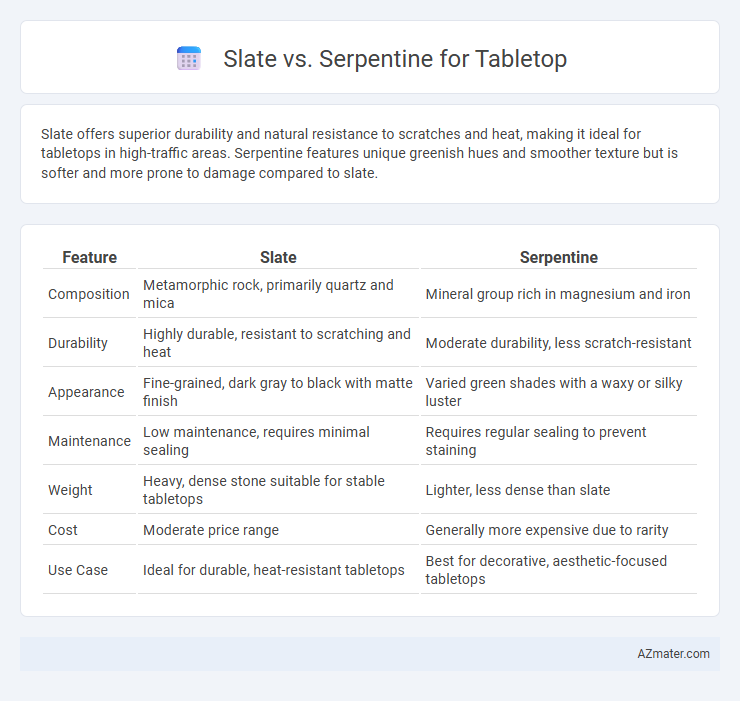Slate offers superior durability and natural resistance to scratches and heat, making it ideal for tabletops in high-traffic areas. Serpentine features unique greenish hues and smoother texture but is softer and more prone to damage compared to slate.
Table of Comparison
| Feature | Slate | Serpentine |
|---|---|---|
| Composition | Metamorphic rock, primarily quartz and mica | Mineral group rich in magnesium and iron |
| Durability | Highly durable, resistant to scratching and heat | Moderate durability, less scratch-resistant |
| Appearance | Fine-grained, dark gray to black with matte finish | Varied green shades with a waxy or silky luster |
| Maintenance | Low maintenance, requires minimal sealing | Requires regular sealing to prevent staining |
| Weight | Heavy, dense stone suitable for stable tabletops | Lighter, less dense than slate |
| Cost | Moderate price range | Generally more expensive due to rarity |
| Use Case | Ideal for durable, heat-resistant tabletops | Best for decorative, aesthetic-focused tabletops |
Introduction to Slate and Serpentine Tabletop Materials
Slate and serpentine are popular materials for tabletop surfaces due to their durability and unique aesthetic qualities. Slate, a fine-grained metamorphic rock, offers a smooth, matte finish with natural clefts that add texture and character, making it ideal for rustic or modern designs. Serpentine, a group of greenish minerals, provides a distinctive veined appearance and a slightly softer, more polished surface, valued for its elegance and resistance to heat and moisture.
Appearance and Aesthetic Differences
Slate exhibits a smooth, fine-grained texture with a consistent dark gray to black coloration, offering a sleek and modern tabletop appearance ideal for minimalist and contemporary decor. Serpentine features a rich, variegated pattern with green, gold, and brown hues, providing an organic, luxurious aesthetic that adds warmth and a natural feel to tabletops. The contrasting color palettes and surface textures of slate and serpentine make them distinct choices for creating either understated elegance or eye-catching, earthy designs in tabletop applications.
Durability and Longevity Comparison
Slate offers exceptional durability and resistance to scratches and heat, making it ideal for long-lasting tabletop surfaces. Serpentine, while visually appealing with its unique patterns, tends to be softer and more prone to chipping and wear over time. When comparing longevity, slate generally outperforms serpentine due to its harder composition and superior structural integrity.
Cost and Affordability Analysis
Slate offers a more budget-friendly option for tabletop surfaces, generally priced between $5 to $15 per square foot, making it accessible for various project scales. Serpentine, often considered a premium choice, can range from $20 to $40 per square foot due to its unique mineral composition and aesthetic appeal. The cost disparity is influenced by availability, processing complexity, and durability requirements, with slate providing a practical balance between affordability and performance for most tabletop applications.
Maintenance and Care Requirements
Slate tabletops require minimal maintenance, needing only occasional sealing to prevent staining and moisture absorption, while their smooth surface is easily cleaned with mild soap and water. Serpentine tabletops demand more frequent sealing and careful cleaning to protect their porous surface from scratches and staining, as well as avoiding harsh chemicals. Both materials benefit from regular dusting and prompt spill removal to maintain their durability and aesthetic appeal.
Environmental Impact and Sustainability
Slate and serpentine differ significantly in environmental impact and sustainability when used for tabletops. Slate mining, often associated with high energy consumption and landscape disruption, raises concerns about habitat destruction and water pollution. Serpentine, while less energy-intensive to extract, may contain naturally occurring asbestos, posing health risks and requiring careful management to ensure sustainable and safe use in furniture production.
Weight and Installation Considerations
Slate is denser and heavier than serpentine, making it more durable but challenging to handle during tabletop installation. Its substantial weight demands sturdy support structures to prevent sagging or damage over time. Serpentine, being lighter and more flexible, offers easier installation and requires less reinforcement, ideal for custom or intricate tabletop designs.
Suitability for Indoor and Outdoor Use
Slate offers excellent durability and water resistance, making it highly suitable for both indoor and outdoor tabletop use, especially in areas prone to moisture and temperature fluctuations. Serpentine, while visually appealing with its unique green hues, is softer and more porous, which makes it better suited for indoor tabletops where it can be protected from weathering and staining. The hardness and low porosity of slate contribute to its superior longevity and ease of maintenance in varied environmental conditions.
Pros and Cons of Slate Tabletop
Slate tabletops offer exceptional durability and a natural, elegant appearance, making them ideal for both indoor and outdoor use. Their dense composition resists heat, scratches, and moisture, but the material's weight can pose challenges during installation or relocation. While slate provides a unique aesthetic and long-lasting surface, it may require periodic sealing to prevent staining and maintain its rich color.
Pros and Cons of Serpentine Tabletop
Serpentine tabletops offer unique, elegant curves that enhance aesthetic appeal and provide ergonomic benefits by allowing easier reach across the surface compared to traditional rectangular shapes. However, serpentine tables are typically more expensive due to their complex design and require precise craftsmanship, increasing maintenance challenges. Their ornate shapes can limit placement options in smaller rooms and may reduce usable tabletop area, which is a consideration for tabletop gaming or multi-purpose use.

Infographic: Slate vs Serpentine for Tabletop
 azmater.com
azmater.com